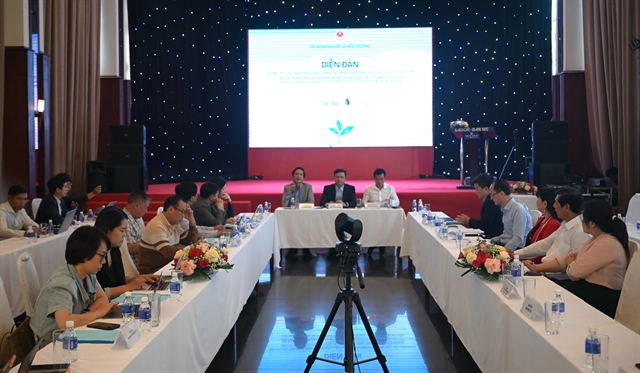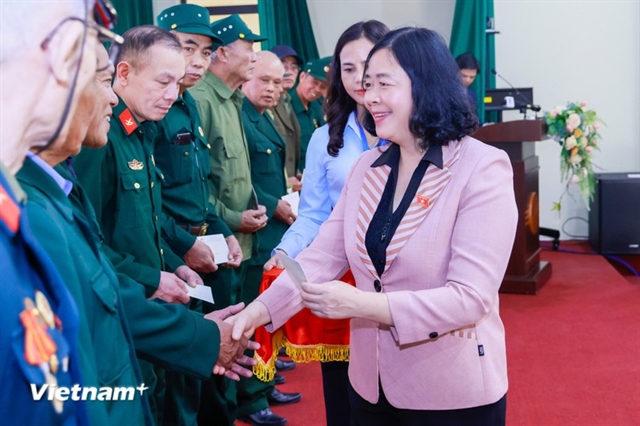 Features
Features
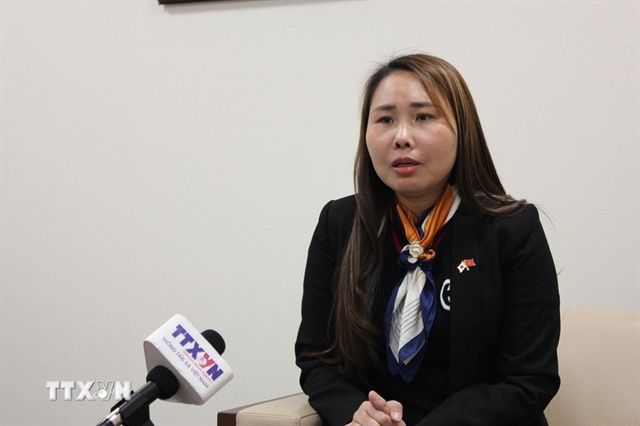
The Hà Nội authorities have drafted a plan to develop the culture industry from 2021 to 2025, with a vision to 2045. The document is considered important to paving the way for the city’s culture industry to develop sustainably.
Lê Hương
The Hà Nội authorities have drafted a plan to develop the culture industry from 2021 to 2025, with a vision to 2045. The document is considered important to paving the way for sustainably developing the city’s culture.
Great potential
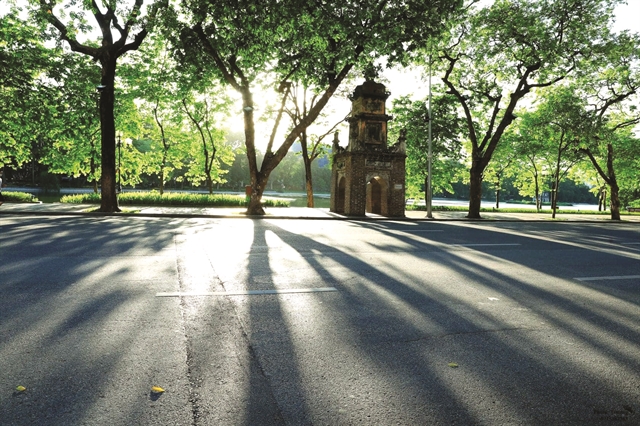
|
| Hòa Phong Tower, a remnant of Báo Ân Pagoda built in 1842 by Hoàn Kiếm Lake in downtown Hà Nội. VNS Photo Trương Vị |
There is a dense system of nearly 6,000 places of cultural and historical interest in Hà Nội (former name Thăng Long) and the surrounding neighbourhood, as well as hundreds of traditional festivals representing different local communities.
According to the Chairman of the Việt Nam Archaeologists’ Association, Tống Trung Tín, the Thăng Long Imperial Relic Complex deserves the World Culture Heritage title, as it is a treasure in the middle of the city, representing the valuable heritage of the former royal capital city of Thăng Long.
Hà Nội is teeming with a vast array of culture, including large numbers of traditional handicraft villages, which are core to the local Vietnamese culture, not to mention the famed Old Quarter with its iconic 36 guild streets.
“The city has 292 handicraft villages ranging from lacquer, embroidery, silk weaving and pottery to bamboo and rattan basketry, metal casting and statue carving,” said Hà Thị Vinh, chairwoman of Hà Nội Fine Arts and Handicraft Villages Association.
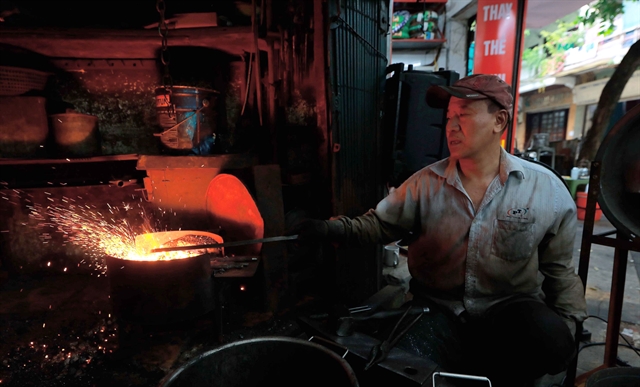
|
| Nguyễn Phương Hùng, the last blacksmith, follows his father's footsteps to keep the traditional craft in Lò Rèn (Blacksmith) Street in Hà Nội’s Old Quarter. VNS Photo Trương Vị |
Many artisan's of the villages have huge revenues and have joined the billionaire’s club such as in Sơn Đồng Sculpture Village, Bát Tràng Pottery Village and Vạn Phúc Silk Village.
The city’s architecture heritage gathers diversified styles, including European and Vietnamese. Typical buildings include the State Bank, the Post Office, St Joseph Cathedral, Hàm Long Church, the President’s Palace, the Metropole Hotel and many more.
Indochinese architecture appears in various central streets and villages on the outskirts such as Cựu Village in Vân Từ Commune of Phú Xuyên District, and Cự Đà Village in Cự Khê Commune of Thanh Oai District.
Trần Đức Cường, PhD, chairman of Việt Nam History Science Association, said the city could be compared with many other famed cities across the world.
“Guild streets and handicraft village as well as other cultural and historical heritage sites, both urban and rural spaces, are all cultural products, and show the creativity of the cultural industry,” he said.
Current times
The cultural and creative industries account for some 3 per cent of national GDP, while the city’s portion is 3.7 per cent of GRDP.
Lê Thị Minh Lý, deputy chairperson of Việt Nam Culture Heritage Association, noted that the city had many strong points in developing its cultural industry.

|
| People enjoy the Japan Cherry Blossoms Festival in September 2019 in downtown Hà Nội. VNS Photo Trương Vị |
“The city possesses a rich and diversified stock of heritage, which is an important source of cultural industry,” she said. “The region gathers talent and creative people, who are both hosts and consumers of cultural goods and services."
Associate Professor Bùi Hoài Sơn, a permanent member of the National Assembly’s Culture and Education Committee, said Hà Nội had the most potential in culture when compared to any other city in the country.
“The city’s cultural source if being effectively used will not only create cultural products but also offer an advantage in developing the economy, to make the city more alluring,” he said. “It will be a pity if we don’t know how to use this for the city’s development.”
Hà Nội has nearly 6,000 historical relic sites; over 1,700 elements of intangible cultural heritage; over 1,300 handicraft villages; over 1,170 festivals and cultural and art events; as well as 115 multi-purpose creative spaces.
The authorities have issued policies for the creation of cultural products and services and paid more attention to investing in cultural heritage.
The city has been listed among 66 creative cities recognised by UNESCO.
There have appeared many new cultural and art events such as the Hà Nội International Film Festival; a contest for designing the city’s fine arts products; the Hanoi March Connecting international fine arts exhibition; the Hà Nội International Fine Arts and Gift Fair; the South Korean Culture Festival; the French Culture & Cuisine Festival; the Contemporary Folk Arts Festival; and the RMIT Creative Design Festival to name just a few.
There have been more and more high quality creative spaces for the local community such as Sword Lake pedestrian zone; Phùng Hưng Graffiti Street; Phúc Tân Culture & Art Space; Hà Nội Book Street; and many, many more.
Obstacles
However, despite the burgeoning of the capital as an up-and-coming creative space, there have been many challenges.

|
| People watch a film at Ở Kìa Hà Nội creative space. Photo from Facebook of the space |
The creative space Ơ Kìa Hà Nội run by film director Nguyễn Hoàng Điệp has had to move three times since it first opened in 2017 as the landlord no longer wanted to rent the property.
For the same reason, 60S Thổ Quan creative complex has stopped operation. Dozens of brands had to end their operation after three years of running in the complex, which hosts various youth-inspired events.
“Creative spaces have been considered as pure enterprises, and have not been supported in the rental of properties or other favourable policies,” said Cao Trung Hiếu, co-initiator of 60S Thổ Quan Creative Complex. “Many spaces cannot run for a long time as the rental price is too high for them or the landlords do not appreciate creative cultural values.”
Lê Quang Bình, coordinator of network ‘For a Hà Nội Worth Living in’, said: “Because they don’t have proper legal capacity, owners of creative spaces have found it hard to ask for permissions to operate spaces. All the existing creative spaces are running under the Law of Enterprise.”
Đoàn Kỳ Thanh, who initiated the Hà Nội Creative City, said that it had no right to host cultural events as a real estate enterprise owner would.
Hà Nội’s film industry has lagged behind other cities, and playwright Nguyễn Thị Hồng Ngát believes that the authorities have neglected cinema.
“There have been no proper unified policies to encourage cinema enterprises to develop,” she said.
The performing arts field has the same problem.
Trần Ly Ly, director of Việt Nam National Opera and Ballet Theatre, said that a high quality art project should be cared for in various angles and could take 10 to 20 years to attract tourist attention.
“We often run short and high-priced projects with improper investment, resulting in low quality products and reduced attraction to the public,” she said.
Composer Nguyễn Quốc Trung said that there had been no proper outline for developing cultural spaces in the city.
“Cultural products have been interfered too much from too many agencies before being published,” he said. “The censorship sometimes is imposing, strict and backward, which has hindered the creativity of artists.”
Many experts say that folk culture and handicraft products have not been properly developed as a tourist magnet.
Nguyễn Thị Thu Phương, PhD, from the Việt Nam National Culture and Arts Institute, said in the past few years though there had been a much improved environment, the city had not created any breakthrough to liberate creativity and promote cultural expression.
“The city has not brought into full play the soft power of culture though the cultural industry to develop the city’s whole strength,” she said.
The Rector of the Lê Hồng Phong Public Employees Training School, Phạm Minh Anh, raised her voice on copyright issues, which have been a challenge to developing the culture industry in the city.
“Copyright violation happens in every field, which has not only hindered creators but also harmed the competitiveness of the market and is a big obstacle for the forming of a cultural industry," she said

|
| Women visit the Thăng Long Citadel Complex in downtown Hà Nội. VNS Photo Trương Vị |
Ly also suggested that there had been a lack of proper legal regulations for enterprises of culture and creativity.
Nguyễn Thành Phong, deputy secretary of the city’s Party Committee, said the city considered enterprises, artists, artisans and ordinary people as the hosts for developing the culture industry.
“The State will create a legal corridor for creative authors to make contributions and enjoy their creative process,” he said. “In our legal framework, the Hà Nội authorities will spare no efforts to create an environment for the cultural sector to develop. Hà Nội pledges to actively seek valuable creative agencies, organisations and models to invite them to develop for mutual benefit.”
Despite the numerous challenges, with its incredible sweep of history, handicrafts, art and tradition, the capital's cultural industry is well placed to go from strength to strength. VNS

|
| Tràng Tiền Street in downtown Hà Nội gathers many French buildings, dating back to the period when France ruled Indochina. VNS Photo Trương Vị |

